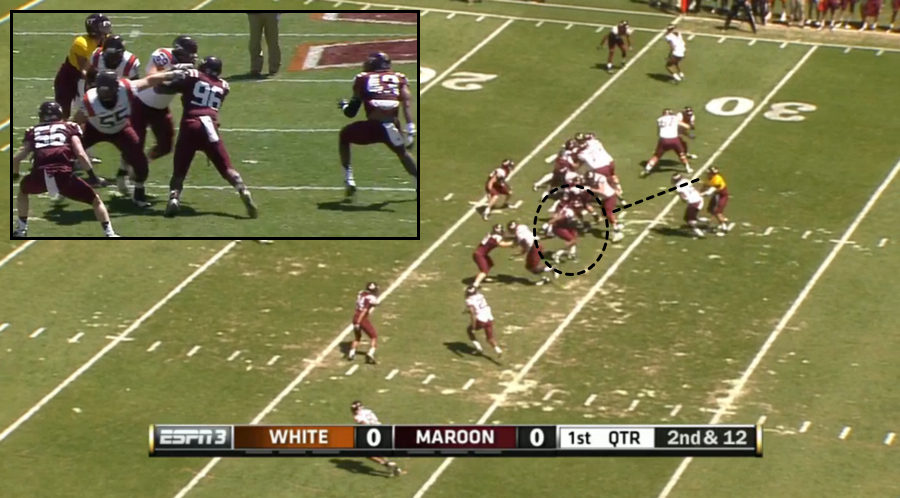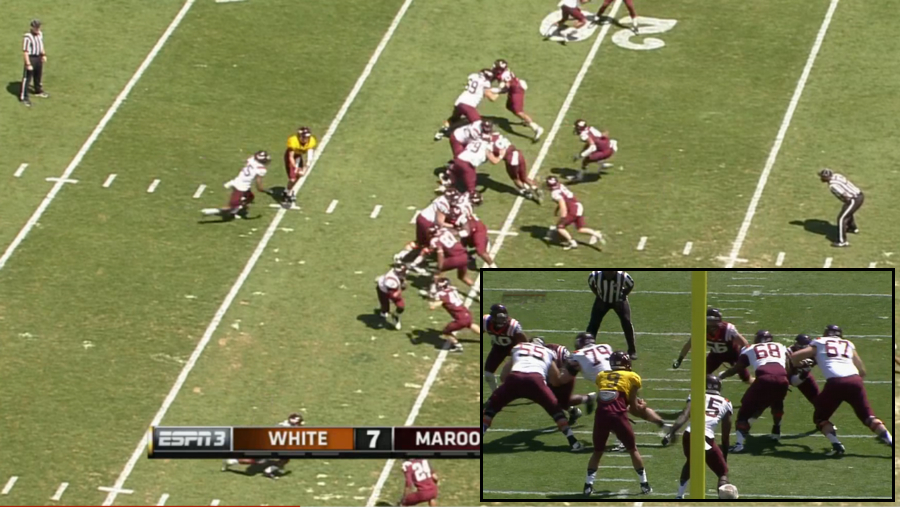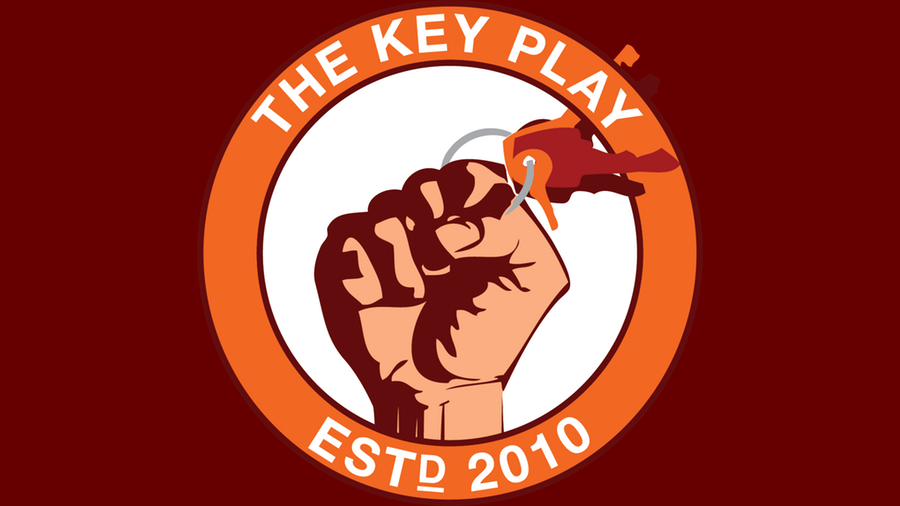The Maroon–White game was the first time I got to watch the Hokies scrimmage this spring. The four-hour down-and-back I-81 to Blacksburg isn't as doable with a three-month-old as it once was. Even though French and Mason were at the open scrimmages and told me Loeffler had incorporated more zone read into the playbook, it still popped out on film for me.
The zone read series is something Tech fans clamored for during the Tyrod Taylor era, but never really saw much of in Blacksburg. The logic back then was something like, "Hey, we've got a fast and elusive QB, why aren't racking up yards like WVU or Oregon." Easier said than done. Like the inverted veer we saw Logan Thomas run so much last season, the zone read is a play that requires good ball skills and decision making by the quarterback. However, the quarterback won't be trying to hammer through the heart of the box.
The Tech-versus-Tech battle only featured a single touchdown. However, Joel Caleb scored on an inside zone read (IZR). As the excellent website covering Oregon, FishDuck.com notes, the formation in the backfield is a tell for whether the play is inside or outside zone read (OZR). When the running back is behind and to the side of the QB, it's IZR. If the running back is nearly the same depth and next to the QB, then it's likely OZR.
Much like the base version of the inside zone, this is a physical running play. If Tech's scheme is similar to those taught elsewhere, the o-line is going to take a quick, short, 45 degree step to the play side. Covered linemen (have a defender in front of them) are going to look to immediately drive block their man off the ball. Uncovered linemen are going to "zone block". That is help the nearest covered lineman (in the play side direction) drive their defender off the ball. Ideally, as the two offensive linemen hit the second level, one will come off the double-team to pick off a linebacker, or defensive back flying into the fray.
00:00:48–00:00:56
Brenden Motley is reading/optioning defensive end Seth Dooley (No. 43).

If Dooley crashed down inside, Motley would've kept and tried to gain what he could've in the gap previously occupied by Dooley. Instead, Dooley stays at home. Motley gives to Caleb, who is looking to run off the butt of the play side guard. In this case it's Adam Taraschke (No. 70). He reads the blocks beautifully and heads for daylight. Note the zone block by Caleb Farris and Taraschke. Before the ball is snapped, Farris is uncovered so he joins Taraschke and the two of them double-team the DT. After they've established leverage, Taraschke peels off and picks up the linebacker. Bucky Hodges, who is lined up at tight end away from the play side, actually steps away from the play and widens. This is a bit of a wrinkle, and French has discussed the veer release technique at length, so I'm not going to go into detail. Had Dooley crashed, Hodges was all over Di Nardo and Motley would've picked up a nice gain if he kept it.
Motley and Tech ran the inside zone read a few times on the day, but it wasn't all sunshine and lollipops.
00:04:04–00:04:08
Dewayne Alford (No. 87) is the read man. Alford's responsibility is the quarterback. He squeezes down the line and forces Motley to give to the tailback. It's hard to tell by the angle, but it seems like a judgement call whether to give or keep.
Either way, the o-line does a great job of getting on their double teams at the start of the play. Caleb Farris and Parker Osterloh are both uncovered so they step left to the play side to help out. The play degrades when Marcus Mapp (No. 68) does not effectively get off the double-team to pick up linebacker Sean Huelskamp (No. 56).

Huelskamp had an impressive scrimmage, and in Mapp's defense, properly executing that double-team block requires technique, timing, and familiarity (with the other guys on the line). Mapp was buried on the depth chart at guard, and got as much playing time as he did in the spring game because Augie Conte and Alston Smith didn't participate. There's no way he got enough practice reps in April to feel good about making that block.
Caleb tries to get what he can, but Huelskamp makes the tackle, and Alford is there to handle any shenanigans.
The OZR features some subtle differences from IZR. The o-line takes a more open step to the play side to reach the defender and widen the d-line. The uncovered/covered double-team blocking concept still applies. The running back aims outside of the play side OT instead of the guard. Similarly to the vanilla outside zone, if the d-line overplays and gets going too far east-west they can take themselves out of the play. The back can then cut back into the box. As an o-lineman in high school, I was taught to ride the defender past where he wants to go. Among other things, a tailback needs great vision and decisive cut to succeed running this play, because the "hole" can form anywhere.
As best I can tell, Tech didn't call any outside zone read during the spring game. However, it was a favorite of Loeffler's against Virginia last season.
00:13:42–00:14:00
Note the alignment of Trey Edmunds. As I mentioned above, he's flanked to the right of, and at the same depth as, Logan Thomas. Tech leaves UVa's back side defensive end (No. 90) unblocked on each play. Like on the IZR, the back side tight end, Kalvin Cline (No. 93), veer releases. Unlike Tech, Oregon's back side tight end or H-Back zone blocks along with the rest of the o-line. Without being in the meeting room, I can't give a definitive explanation as to why Loeffler does this. A guess is because it helps to fool the secondary. If they're reading the tight end, and he's not zone blocking, they can't immediately diagnose run as the threat of play-action or packaged screen exists. On both plays, the zone blocks by Farris and Wang were marvelous. Off the ball they double the d-tackle and then neutralize the play side defender at the second level. Each time McLaughlin reaches the end and has him rolling around on skates. Trey cuts it up the field at the numbers each time.
And now that you're at the end of this post, a caveat. It's impossible to say with 100% certainty that any of these plays are zone "reads". There's zone blocking up front, the back side defensive end is unblocked, the QB/RB form a mesh point, and QB seems to make a decision with the football. However, it's entirely possible the decision to give or keep was made in the huddle, or is predetermined based off of alignment pre-snap. Either way, like those of us watching, it's unlikely the defense knows the difference.
The IZR and OZR compliment each other, so I'll be on the watch to see if OZR is practiced this summer. Loeffer is on the record saying he believes the QB has to be involved in the running game. Motley, Michael Brewer, Chris Durkin, and Andrew Ford can all make plays with their legs. August should shed some light on which of the QBs might be successful executing the zone read series.


Comments
Please join The Key Players Club to read or post comments.
Please join The Key Players Club to read or post comments.
Please join The Key Players Club to read or post comments.
Please join The Key Players Club to read or post comments.
Please join The Key Players Club to read or post comments.
Please join The Key Players Club to read or post comments.